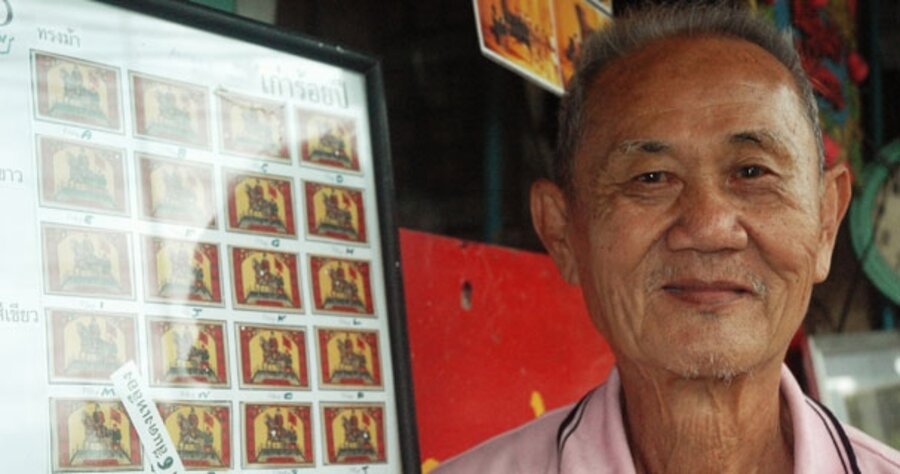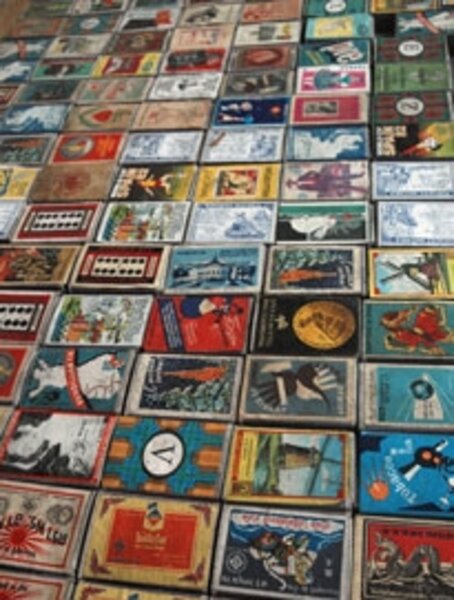Matchbox museum offers small view of big history
Loading...
| Bangkok, Thailand
Bangkok, Thailand
In the late 1930s, inspired by his father’s friends trading old coins and other collectibles, the 10-year-old son of a Chinese gold dealer in the northern Thai town of Nakhon Sawan took a shine to a used matchbox.
Its stamp-size label, produced by a local match mill, showed the 19th century monarch, King Chulalongkorn, astride a white stallion. The image was modeled on the venerated king’s 1908 equestrian statue, an object many Thais still regard as sacred. The boy was charmed by his find.
“I thought it was beautiful,” remembers Chuan Sunthranan, now an octogenarian. A box of matches then cost just a satang (1 cent), he notes, so they were “cheap and easier to collect than stamps, which other boys like to collect.”
As Thailand was being swept up in World War II, the boy began scouring teashops and going door to door in search of used matchboxes, peeling or steaming off labels for his growing collection.
Chuan’s boyish zeal never let up for seven decades as he married, inherited his father’s shop, raised five children, and relocated to Bangkok – all against the backdrop of Thailand’s 15 coups, involvement in the Vietnam War, and bloody crackdowns on pro-democracy movements. Much of that turbulent history is now reflected in his vast collection of matchbox labels – kept in his private “Matchbox Museum.”
It took him 20 years – during endless visits to flea markets and barters with fellow collectors – to complete his equestrian set. It consists of identical labels picturing the king on horseback with a pennant. There were 26 labels in the series – each showing the pendant with a different letter from A to Z. Chuan claims he has cobbled together the only set surviving. Though he’s had his set for a half century and his collection now boasts sets from 120 countries, he still prizes the Thai equestrian series above all.
Unlike most adolescent collections (bottle caps, stamps, baseball cards) that end up in moldy basements, cobwebbed attics, or dumpsters, the fruits of Chuan’s magpie-like enthusiasm now have their own museum. Last year, the elderly collector converted his shophouse in an outlying Bangkok district into the “Matchbox Museum” open to the public.
• • •
The springy octogenarian, dressed on a recent day in a pink polo shirt with a Boy Scout logo, can hardly sit down on his shop stool before jumping up again. His trouser legs bunched around his sandaled heels, he scurries around jammed bedroom-size space to point out remarkable exhibits as he navigates the clutter of tabletops stacked with framed cardboards mounted with labels, displays propped up on the floor for want of space, glass cases hung on walls and simply tagged “Beautiful Matchboxes,” and stacks of labels spilling out the doors. Pausing here and there, he exclaims in limited English, “Only one in the world!”
There is no exhibit map; it’s all in Chuan’s head. “I’m my own curator,” hesays of the haphazard arrangement.
“I want to pay homage to one of mankind’s greatest inventions,” he explains.
• • •
In hindsight it seems like a no-brainer – a little stick tipped with a blob of phosphorus ignited on an abrasive surface, or “grit,” for lighting a fire. Yet from kindling and flint it took several millennia for the friction match to arrive in 1827 (courtesy of John Walker, a British pharmacist). Anyone could now own fire, thanks to a wonderfully simple, handy device shorter than a pinkie.
Soon matches were sold by the dozens in little cardboard boxes with sleeves richly labeled for trademark and advertising purposes by myriad match mills. To rise above the competition, manufacturers (by the late 19th century they numbered several hundred worldwide) began churning out a kaleidoscope of decorative and promotional labels produced by inspired graphic artists.
Collectors weren’t far behind. Matchboxes, their utilitarian purpose subverted, came to be viewed as objets d’art; like Chuan, many collectors have never smoked, or even used matches much. Phillumeny, as the collecting of match-related ephemera came to be called, gained a devoted global following rivaling philately, or stamp collecting.
“There is an endless variety of [old] matchbox labels far in excess of stamps,” says Steven Smith, president of the world’s oldest matchbox club, the British Matchbox Label and Booklet Society. “It’s a never-ending challenge just to get every label [ever] produced in a single country.”
Fortunately for phillumenists, collectible labels are a lot cheaper than stamps. Last year at an eBay auction Mr. Smith – who became a collector at age 7 while trawling for unusual matchboxes discarded by sailors and holidaymakers in his native Norwich, England – bought what he thinks is the most expensive label ever: an American piece from around 1870. He paid a record $7,500 for it (which would be a relatively modest sum for a rare stamp). As with stamps, Smith explains, a matchbox label’s value is not just in its beauty but its rarity and vintage.
Historical association also matters. Matches were once ubiquitous, and their labels reflected the world around them – from fashionable society salons in London to rustic homes with a cooking pot in China or India.
“Matchbox labels are windows onto the past, reflecting a bygone era’s styles, trends, and concerns,” Chuan says. “You can study a country’s history just by looking at old matchboxes.”
As examples, he unearths items from a century ago celebrating Thailand’s first steam engine railway and Bangkok’s tram. From another pile, he produces some yellowed labels bearing slogans by a World War II-era dictator, who used matchboxes as a medium for propaganda.
A contemporary matchbook, meanwhile, boasts sepias of a Thai prince (Chulalongkorn’s grandson) and his foreign-born wife printed on its two sides. He postulates that the unique collector’s item, made for an exclusive banquet at the palace, was saved for posterity by a souvenir-hunting courtier.
Other labels from the 1950s extol rural life in bucolic images, plug American Zenith television sets to wealthy urbanites, or laud the arrival of modern gas stations. By the 1980s, many Thai matchboxes wooed tourists with promotional images of picturesque landscapes.
Among Chuan’s many foreign acquisitions, some exhibits depict Chairman Mao in a series of adulatory iconography; show views of the Kremlin from Soviet-era matches for the proletariat; or feature Rudolph Valentino, Errol Flynn, Jean Harlow, and other silent-movie stars on a Finnish set.
Yet such “repositories of knowledge and memory,” as Chuan puts it, are becoming a thing of the past.
Except for remote rural areas in the developing world, disposable lighters and electronic ignition have usurped the role of once-indispensable matches. Match manufacturing isn’t what it used to be, and that bodes ill for a proud tradition of collecting.
“Sad to say we’re in decline,” laments Smith, a close friend of Chuan. “Most collectors are in their 70s and few young people are interested in old matchboxes.”
When one of the last Thai match mills went out of business recently, Chuan bought up its entire inventory – not just 100,000 plastic-wrapped labels, but bulky canvas bales of headless matchsticks, too. He even acquired the propeller of the factory’s longboat once used for servicing households along Bangkok’s canals.
A mile or so away from Chuan’s museum, another multistory home he owns serves as a warehouse for these industry castoffs, while he himself lives in a simple cinderblock bungalow next door.
“We couldn’t have built modern civilization without matches,” the avid collector explains as he putters around in search of further mementos to show off. “I want to preserve their importance for future generations.”






